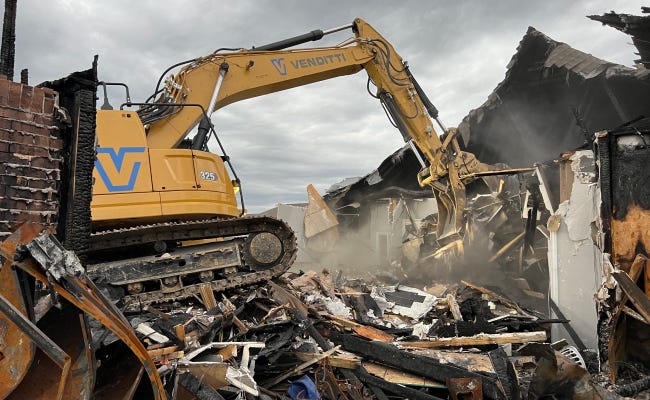Ecological Sustainability in Interior Demolition: Strategies for Responsible Practices
Ecological Sustainability in Interior Demolition: Strategies for Responsible Practices
Blog Article
The Ultimate Overview to Interior Demolition Techniques and Equipments
Within the world of indoor improvements, the art of demolition is a pivotal phase that calls for accuracy, skill, and the right set of devices. Whether you are an experienced professional or a DIY enthusiast, recognizing the intricacies of indoor demolition strategies can make all the distinction in achieving an effective job outcome. As we browse via the subtleties of this detailed guide, we will certainly discover necessary tools, safety and security procedures, and expert methods that are essential when getting started on the journey of transforming a space. Keep tuned to discover the vital understandings that can boost your demolition expertise to new elevations.
Necessary Interior Demolition Devices
When embarking on interior demolition tasks, having the proper tools is vital for performance and security. One of the most crucial devices for interior demolition is the demolition hammer. This heavy-duty tool is made to break through tough materials like concrete, drywall, and tile.
Another crucial device is a reciprocating saw, which is ideal for cutting with a selection of materials such as plastic, metal, and timber. Its capacity to make precise cuts in tight areas makes it ideal for demolition work. Furthermore, an energy knife is necessary for cutting materials like carpeting, plastic floor covering, and insulation. Its sharp blade guarantees clean and precise cuts, promoting the removal of unwanted products. Overall, having these essential interior demolition devices will dramatically improve the performance and safety of any kind of demolition project.

Safety Safety Measures During Demolition

Additionally, all employees involved in the demolition process must receive ample training on the correct handling of tools and devices to decrease accidents. By adhering to these safety preventative measures, interior demolition projects can be brought out effectively while prioritizing the health of all individuals involved.
Methods for Removing Walls
Executing correct security preventative measures during indoor demolition projects is crucial for developing a protected workplace, and one key facet of such jobs involves understanding methods for eliminating walls. One typically used method is hand-operated demolition, which calls for making use of standard hand devices such as sledgehammers, crowbars, and utility knives to thoroughly take apart the wall item by piece. This technique permits greater control over the demolition procedure, especially in fragile areas where precision is essential.
For larger, a lot more intricate wall surfaces, mechanical demolition might be required. This includes utilizing hefty equipment like bulldozers or excavators to tear down walls successfully. It is crucial to make sure that the architectural honesty of the structure is not endangered throughout mechanical demolition.
Another technique for removing walls is deconstruction, where the wall is taken apart in such a way that maintains recyclable materials. This lasting technique is ecologically friendly and can also help minimize disposal expenses. Whichever technique is used, it is crucial to follow appropriate safety and security protocols and consider the architectural effects of wall removal to make sure a successful indoor demolition task.
Removing Flooring Like a Pro
Successfully removing flooring during interior demolition needs the correct devices and strategies to ensure a successful and smooth procedure. The primary step in getting rid of floor covering is to get rid of the location of any type of furnishings or challenges. Next, determine the sort of floor covering to figure out the proper removal method. For hardwood or laminate floor covering, beginning by removing the baseboards and after that utilize a flooring scraper to lift and detach the planks. Rug elimination entails cutting the carpet into workable areas and rolling it up for disposal. For floor tile or vinyl flooring, a carve or floor scraper can be made use of to pry up the floor tiles or sheets. It's necessary to put on protective gear such as handwear covers, safety glasses, and a mask to avoid injuries and direct exposure to dirt and particles. In addition, having a dumpster or assigned disposal location all set for the removed flooring materials is vital for keeping a tidy work environment. By complying with these methods and making web use of the right tools, eliminating floor covering like a pro can be achieved effectively and effectively.
Correct Garbage Disposal Techniques
After efficiently eliminating floor covering utilizing the ideal devices and techniques, the next critical action in the interior demolition process is carrying out proper garbage disposal techniques. Appropriate garbage disposal is essential for maintaining a tidy and risk-free workplace throughout and after demolition. Among the main techniques for waste disposal is segregating materials right into various groups such as recyclable, harmful, and general waste. This segregation guarantees that materials are gotten rid of properly and properly.

Specialists need to comply with neighborhood policies relating to garbage disposal to avoid charges and fines. Using expert waste administration services can improve the disposal process and make sure conformity with ecological guidelines. By applying appropriate waste disposal methods, interior demolition tasks can be finished successfully and sustainably.
Final Thought
In conclusion, interior demolition needs the usage of necessary devices and rigorous safety and security preventative measures to ensure a secure and effective procedure. By adhering to these standards, indoor demolition can be finished properly and with very little risks.
One of the most crucial devices for interior demolition is the demolition hammer (interior demolition). On the whole, having these necessary interior demolition devices will dramatically improve the effectiveness and safety and security of any kind of demolition job
Efficiently getting rid of flooring during indoor demolition needs the correct tools and strategies to make sure a smooth and successful process.After effectively removing flooring utilizing the ideal devices and strategies, the next crucial action in the interior demolition procedure is additional hints carrying out proper waste disposal site web techniques.In conclusion, indoor demolition requires the usage of important devices and strict safety and security precautions to make sure a safe and successful process.
Report this page